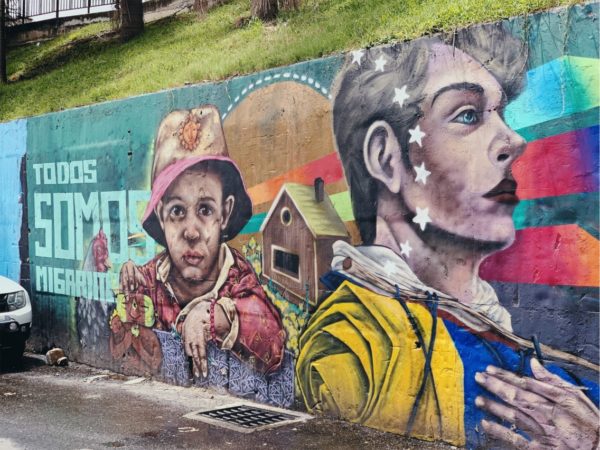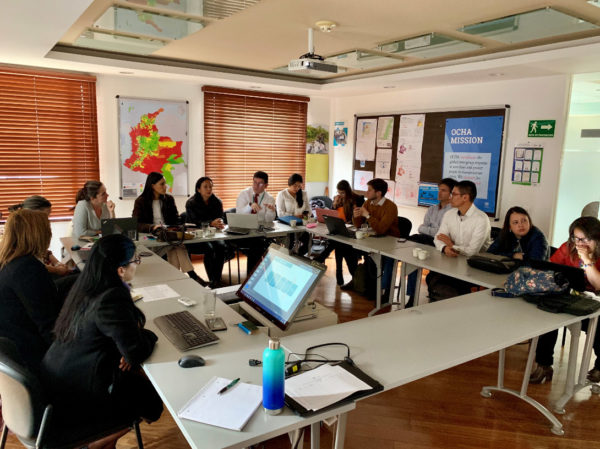Understanding the Complex Dance between Ignorance and Welcome in the Venezuelan Migration Crisis
By Jahnavi Prabhala ’22
Summer Fellows Cohort 2019
IMMAP, Bogotá, Columbia
Staring out the car window, I sat in the back of the car and observed the daily lives of Bogotanos at 7:00 AM. I had a million thoughts buzzing in my head, as Jorge, my supervisor, reiterated the objective and specific guidelines of this mission. We were heading to Usme, a region in Bogotá, to conduct a pilot study investigating the quantitative and qualitative Humanitarian Needs Assessments our team had been working on. This was my first time interacting with the Venezuelan migrant community at an interpersonal level. I didn’t know what to expect.
Driving up into the higher-altitude region of Usme, I could immediately sense the differences from Chico, the region in Bogotá where I was living. As we arrived in Usme, I shivered to the crisp gusts of wind and chilly temperatures. I was shocked to observe how many people didn’t have shoes or jackets. I later learned that many of these people were migrants that were not expecting such cold temperatures when they arrived to Usme, and did not have the money to buy weather-appropriate clothing. Strolling through the streets, I observed the poor infrastructure of many of the small houses and local shops. Throughout the day, we went to a couple places where migrant families were taking shelter to conduct the pilot Humanitarian Needs Assessments.
The purpose of this mission was to talk to migrants one-on-one, to hear their stories, and learn about their journey from Venezuela to Colombia, their current state, future plans, etc. We wanted to learn about their needs and if we could provide them with any information or network for further resources. In order for international, national, and local actors to properly respond to the Venezuelan Migration Crisis, they need to clearly understand the needs of people from all different backgrounds and regions. Thus, our main objective for conducting (or piloting) these assessments was to try and understand what these people were going through, and report our findings with the public and private sector actors working on this issue.
When meeting with the first two migrant families, I just observed the atmosphere and conversation, taking detailed notes as the team conducted the assessment. Before we met with the third family, however, Jorge pulled me aside and shared that he wanted me to talk with the female migrants. He thought I could help them open up as I was the only female representative on this pilot-assessment mission, had previous mental health first aid training, and went through all of the additional WHO and UN humanitarian mental health first aid and other trainings for field workers. The life of each migrant is different, with distinct backgrounds, experiences, and perspectives. In understanding the diversity in peoples’ intersectionality, I was to talk to the female migrants to potentially facilitate the breakdown of inevitable barriers and establish a level of trust during the conversation and assessment.
I could feel a heavy knot in the pit of my stomach, as our team approached the next migrant family. Sitting down with the mother and daughter, who was about my age, I reminded myself about my own position as a foreign American. Although I was not sure how my identity would influence my ability to create a brave space of trust between me and the women I was about to talk to, I remembered the relativity of privilege, being aware of and understanding my own nuanced background and privilege as an Indian-American girl from Northern Virginia. With this in mind, I hoped to lead with empathy, in order to open up a space where I could listen to and learn from these migrant women — a space to “raise my own critical consciousness,” as I learned from the W&M Global Research Institute.
Each conversation I had that day with a migrant woman was filled with difficult subjects to discuss; long and heavy silences; tears; and raw emotions — this wasn’t just me reading about the Venezuelan Migration Crisis in North American or Latin American literature anymore, this was a real crisis with real people. As I treaded carefully with my words and demeanor, I heard things that honestly broke my heart. Many of these individuals were evidently caught in the middle of an invisible dance between xenophobia and the Venezuelan Migration Crisis. Although the dense nature of the needs assessments resurfaced and unleashed the migrants’ painful feelings and experiences, I had to maintain my neutral composure. I felt somewhat helpless during the more delicate moments of my conversations with these women; all I could do was tell them something like, “Toma su tiempo” and “Ahora, estoy aquí para ti” (“Take your time” and “I am here for you right now”), hold their shaking hands, and sit with them in silence. I later saw how those simple words and gestures were enough to mean something to those women, to remind them that they were not forgotten and were cared about, and to indirectly show them that they still had the strength to continue their journey as a migrant, and a person. A large reason as to why the struggle continues between intolerance and welcome, is not just a lack of education, misinformation, or ignorance, it is the complacency with the complexity of truth, fueled by ignorance. As the migrant women opened up to me about their lives, I started to better understand the complexity of the Venezuelan Migration Crisis; The quantitative and qualitative humanitarian needs assessments helped us identify specific trends in the migrants’ current situations and needs in Health; Shelter; Water, Sanitation, and Hygiene (WASH); Food Security; Nutrition; Education; Early Recovery; Protection; and Logistics clusters. Unfortunately, we could not just give everyone what they needed right then and there; there was a process that needed to respect the complexity and the reality of ignorance and bureaucracy as well. This was a long-term process.
After dusk hit the hilly communities of Usme, we ended our assessments for that day and departed back to Chico. As we drove off, I looked back at the communities that welcomed us that day. When the migrant women shared their specific stories with me, I felt an unexplainable feeling that I still cannot articulate to this day. The level of intertwined strength and humility I saw in these migrant women left me without concrete and coherent words. All I knew was that the Venezuelan Migration Crisis was a situation that would take years to simmer down and stabilize. To address the situation at a macro and infrastructural level in the long-term, every individual actor working on this issue must learn and acknowledge the micro and interpersonal experiences of the crisis. It is this same strength and humility that I saw in those women, that will help us fight the ignorance and bureaucracy, and ultimately address, respond, and later rebuild for years after the Venezuelan Migration Crisis.
Comments are currently closed. Comments are closed on all posts older than one year, and for those in our archive.







I enjoyed reading this article. It is insightful , informative and well written. Thank you, Jahnavi.